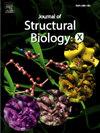金刚烷酮类药物抑制流感病毒A - M2病毒孔蛋白的分子生物物理学和机制——设计抗病毒药物的挑战
IF 5.1
Q2 BIOCHEMISTRY & MOLECULAR BIOLOGY
引用次数: 0
摘要
流感A基质2 (AM2)蛋白是一种原型病毒孔蛋白,它引导质子穿过一系列水分子和可电离氨基酸残基的侧链,其中His37是最重要的。金刚烷胺是一种原型AM2通道阻滞剂和甲型流感AM2野生型(丝氨酸-31)复制抑制剂。金刚烷胺于1966年被批准用于预防甲型流感病毒。然而,金刚烷胺靶向AM2的作用机制是在其被批准为抗甲型流感药物50年后才被确定的。我们展示了AM2 WT和金刚烷胺抗性突变体通道(V27A, L26F, S31N)与金刚烷胺基配体配合物的实验生物物理方法和分子动力学模拟结果。此外,我们还描述了来自生化/功能和分子生物学实验的关键实验证据。以往关于药物结合和抑制机制的争论主要是由于不同的模拟膜环境、药物的过量和使用的方法,而不是实验的准确性。获得的集体知识可以激发针对流感病毒开发新的抗病毒药物的研究,并提供将分子生物物理学应用于其他病毒蛋白的经验。本文章由计算机程序翻译,如有差异,请以英文原文为准。

Molecular biophysics and inhibition mechanism of influenza virus A M2 viroporin by adamantane-based drugs – Challenges in designing antiviral agents
The influenza A matrix 2 (AM2) protein is a prototype viroporin that conducts protons through an array of water molecules and sidechains of ionizable amino acid residues, with His37 being the most important. Amantadine is a prototype AM2 channel blocker and inhibitor of influenza A AM2 wild type (serine-31) replication. Amantadine received approval for prophylaxis against the influenza virus A in 1966. However, the characterization of the mechanism of action of amantadine targeting AM2 came 50 years after its approval as an anti-influenza A drug. We present results from experimental biophysical methods and molecular dynamics simulations for the complexes of the AM2 WT and amantadine-resistant mutant channels (V27A, L26F, S31N) in complex with adamantane-based ligands. Additionally, we describe critical experimental evidence from biochemical/functional and molecular biology experiments. Previous debates on the mechanism of drug binding and inhibition were due to the different membrane mimetic environment, the excess of the drug, and the method used, rather than the accuracy of the experiments. The collective knowledge acquired can inspire research for the development of new antivirals against influenza viruses and provide experience on the application of molecular biophysics to other viroporins.
求助全文
通过发布文献求助,成功后即可免费获取论文全文。
去求助
来源期刊

Journal of Structural Biology: X
Biochemistry, Genetics and Molecular Biology-Structural Biology
CiteScore
6.50
自引率
0.00%
发文量
20
审稿时长
62 days
 求助内容:
求助内容: 应助结果提醒方式:
应助结果提醒方式:


